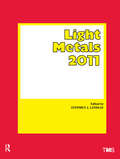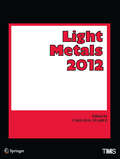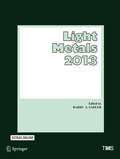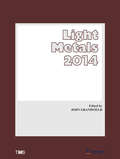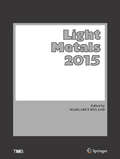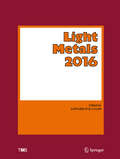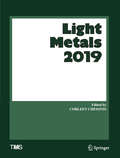- Table View
- List View
Light-Matter Interactions Towards the Nanoscale (NATO Science for Peace and Security Series B: Physics and Biophysics)
by Maura Cesaria Antonio Calà Lesina John CollinsThe investigation of light-matter interactions in materials, especially those on the nanoscale, represents perhaps the most promising avenue for scientific progress in the fields of photonics and plasmonics. This book examines a variety of topics, starting from fundamental principles, leading to the current state of the art research. For example, this volume includes a chapter on the sensing of biological molecules with optical resonators (microspheres) combined with plasmonic systems, where the response this system are described in a fundamental and elegant manner using coupled mode theory. Symmetry plays a major role in the book. One chapter on time reversal symmetry in electromagnetic theory describes how to control the properties of light (e.g. scattering and directionality of the flow of light) in materials with certain topological invariants. Another chapter where symmetry is prominent reformulates, using a gentle and pedagogical approach, Maxwell’s Equations into a new set of fields that reveal a “handedness” symmetry in electromagnetic theory, which can be applied to photonic systems in, for example, the sensing of chiral molecules and understanding the conditions for zero reflection. Also, for students and researchers starting in the field of nanoplasmonics, the book includes a tutorial on the finite element time domain simulation of nanoplasmonic systems. Other topics include photonic systems for quantum computing, nanoplasmonics, and optical properties of nano and bulk materials. The authors take a pedagogical approach to their topic, making the book an excellent reference for graduate students and scientists starting in the fields of photonics or plasmonics.
Light Metals 2011 (The Minerals, Metals & Materials Series)
The Light Metals symposia are a key part of the TMS Annual Meeting & Exhibition, presenting the most recent developments, discoveries, and practices in primary aluminum science and technology. Publishing the proceedings from these important symposia, the Light Metals volume has become the definitive reference in the field of aluminum production and related light metal technologies. Light Metals 2011 offers a mix of the latest scientific research findings and applied technology, covering alumina and bauxite, aluminum reduction technology, aluminum rolling, cast shop for aluminum production, electrode technology, and furnace efficiency.
Light Metals 2012 (The Minerals, Metals & Materials Series)
An update of the definitive annual reference source in the field of aluminum production and related light metals technologies, a great mix of materials science and practical, applied technology surrounding aluminum, bauxite, aluminum reduction, rolling, casting, and production.
Light Metals 2014 (The Minerals, Metals & Materials Series)
The Light Metals symposia are a key part of the TMS Annual Meeting & Exhibition, presenting the most recent developments, discoveries, and practices in primary aluminum science and technology. Publishing the proceedings from these important symposia, the Light Metals volume has become the definitive reference in the field of aluminum production and related light metal technologies. The 2014 collection includes papers from the following symposia: •Alumina and Bauxite •Aluminum Alloys: Fabrication, Characterization and Applications •Aluminum Processing •Aluminum Reduction Technology •Cast Shop for Aluminum Production •Electrode Technology for Aluminum Production •Light-metal Matrix (Nano)-composites
Light Metals 2015 (The Minerals, Metals & Materials Series)
The Light Metals symposia are a key part of the TMS Annual Meeting & Exhibition, presenting the most recent developments, discoveries, and practices in primary aluminum science and technology. Publishing the proceedings from these important symposia, the Light Metals volume has become the definitive reference in the field of aluminum production and related light metal technologies. The 2015 collection includes papers from the following symposia: 1.Alumina and Bauxite 2.Aluminum Alloys: Fabrication, Characterization and Applications 3.Aluminum Processing 4.Aluminum Reduction Technology 5.Cast Shop for Aluminum Production 6.Electrode Technology for Aluminum Production 7.Strip Casting of Light Metals
Light Metals 2016 (The Minerals, Metals & Materials Series)
The Light Metals symposia are a key part of the TMS Annual Meeting & Exhibition, presenting the most recent developments, discoveries, and practices in primary aluminum science and technology. Publishing the proceedings from these important symposia, the Light Metals volume has become the definitive reference in the field of aluminum production and related light metal technologies. The 2016 collection includes papers from the following symposia: 1.Alumina and Bauxite 2.Aluminum Alloys, Processing, and Characterization 3.Aluminum Reduction Technology 4.Cast Shop Technology 5.Electrode Technology 6.Strip Casting
Light Metals 2017 (The Minerals, Metals & Materials Series)
by Arne P. RatvikThe Light Metals symposia at the TMS Annual Meeting & Exhibition present the most recent developments, discoveries, and practices in primary aluminum science and technology. The annual Light Metals volume has become the definitive reference in the field of aluminum production and related light metal technologies. The 2017 collection includes papers from the following symposia:Alumina and BauxiteAluminum Alloys, Processing, and CharacterizationAluminum Reduction TechnologyCast Shop TechnologyCast Shop Technology: Recycling and Sustainability Joint SessionElectrode TechnologyThe Science of Melt Refining: An LMD Symposium in Honor of Christian Simensen and Thorvald Abel Engh
Light Metals 2018 (The Minerals, Metals & Materials Series)
by Olivier MartinThe Light Metals symposia at the TMS Annual Meeting & Exhibition present the most recent developments, discoveries, and practices in primary aluminum science and technology. The annual Light Metals volume has become the definitive reference in the field of aluminum production and related light metal technologies. The 2018 collection includes papers from the following symposia: 1.Alumina and Bauxite2.Aluminum Alloys, Processing, and Characterization3.Aluminum Reduction Technology4.Cast Shop Technology5. Cast Shop Technology: Energy Joint Session6. Cast Shop Technology: Fundamentals of Aluminum Alloy Solidification Joint Session7. Cast Shop Technology: Recycling and Sustainability Joint Session8. Electrode Technology for Aluminum Production9. Perfluorocarbon Generation and Emissions from Industrial Processes10. Scandium Extraction and Use in Aluminum Alloys
Light Metals 2019 (The Minerals, Metals & Materials Series)
by Corleen ChesonisThe Light Metals symposia at the TMS Annual Meeting & Exhibition present the most recent developments, discoveries, and practices in primary aluminum science and technology. The annual Light Metals volume has become the definitive reference in the field of aluminum production and related light metal technologies. The 2019 collection includes papers from the following symposia: 1. Alumina and Bauxite 2. Aluminum Alloys, Processing, and Characterization 3. Aluminum Reduction Technology 4. Cast Shop Technology 5. Cast Shop Technology: Energy Joint Session 6. DGM-TMS Symposium on Lightweight Metals 7. Electrode Technology for Aluminum Production 8. REWAS 2019: Cast Shop Recycling Technologies 9. Scandium Extraction and Use in Aluminum Alloys 10. Ultrasonic Processing of Liquid and Solidifying Alloys
Light Metals 2020 (The Minerals, Metals & Materials Series)
by Alan TomsettThe Light Metals symposia at the TMS Annual Meeting & Exhibition present the most recent developments, discoveries, and practices in primary aluminum science and technology. The annual Light Metals volume has become the definitive reference in the field of aluminum production and related light metal technologies. The 2020 collection includes papers from the following symposia: • Alumina and Bauxite• Aluminum Alloys, Processing and Characterization• Aluminum Reduction Technology• Cast Shop Technology• Cast Shop Technology: Recycling and Sustainability Joint Session• Electrode Technology for Aluminum Production
Light Metals 2021: 50th Anniversary Edition (The Minerals, Metals & Materials Series)
by Linus PeranderThe Light Metals symposia at the TMS Annual Meeting & Exhibition present the most recent developments, discoveries, and practices in primary aluminum science and technology. The annual Light Metals volume has become the definitive reference in the field of aluminum production and related light metal technologies. The 2021 collection includes contributions from the following symposia: · Alumina and Bauxite · Aluminum Alloys, Processing, and Characterization · Aluminum Reduction Technology · Aluminum Reduction Technology Across the Decades: An LMD Symposium Honoring Alton T. Tabereaux, Halvor Kvande and Harald A. Øye · Cast Shop Technology · Electrode Technology for Aluminum Production
Light Metals 2022 (The Minerals, Metals & Materials Series)
by Dmitry EskinThe Light Metals symposia at the TMS Annual Meeting & Exhibition present the most recent developments, discoveries, and practices in primary aluminum science and technology. The annual Light Metals volume has become the definitive reference in the field of aluminum production and related light metal technologies. The 2022 collection includes contributions from the following symposia: • Alumina and Bauxite • Aluminum Alloys, Processing and Characterization • Aluminum Reduction Technology • Aluminum Reduction Technology Joint Session with REWAS: Decarbonizing the Metals Industry • Cast Shop Technology • Electrode Technology for Aluminum Production • Primary Aluminum Industry—Energy and Emission Reductions: An LMD Symposium in Honor of Halvor Kvande • Recycling and Sustainability in Cast Shop Technology: Joint Session with REWAS 2022
Light Metals 2023 (The Minerals, Metals & Materials Series)
by Stephan BroekThe Light Metals symposia at the TMS Annual Meeting & Exhibition present the most recent developments, discoveries, and practices in primary aluminum science and technology. The annual Light Metals volume has become the definitive reference in the field of aluminum production and related light metal technologies. The 2023 collection includes contributions from the following symposia: · 60 Years of Taking Aluminum Smelting Research and Development from New Zealand to the World: An LMD Symposium in Honor of Barry J. Welch · Alumina & Bauxite · Aluminium Industry Emissions Measurement, Reporting & Reduction · Aluminium Waste Management & Utilisation · Aluminum Alloys, Characterization and Processing · Aluminum Reduction Technology · Cast Shop Technology · Electrode Technology for Aluminum Production · Scandium Extraction and Use in Aluminum Alloys
Light Metals 2024 (The Minerals, Metals & Materials Series)
by Samuel WagstaffThe Light Metals symposia at the TMS Annual Meeting & Exhibition present the most recent developments, discoveries, and practices in primary aluminum science and technology. The annual Light Metals volume has become the definitive reference in the field of aluminum production and related light metal technologies. The 2024 collection includes contributions from the following symposia: · Alumina & Bauxite · Aluminum Alloys: Development and Manufacturing · Aluminum Reduction Technology · Electrode Technology for Aluminum Production · Melt Processing, Casting and Recycling · Scandium Extraction and Use in Aluminum Alloys
Light - The Physics of the Photon (Series in Optics and Optoelectronics)
by Ole KellerFrom the early wave-particle arguments to the mathematical theory of electromagnetism to Einstein's work on the quantization of light, different descriptions of what constitutes light have existed for over 300 years. Light - The Physics of the Photon examines the photon phenomenon from several perspectives. It demonstrates the importance of studyin
Light - The Physics of the Photon (Series in Optics and Optoelectronics)
by Ole KellerFrom the early wave-particle arguments to the mathematical theory of electromagnetism to Einstein's work on the quantization of light, different descriptions of what constitutes light have existed for over 300 years. Light - The Physics of the Photon examines the photon phenomenon from several perspectives. It demonstrates the importance of studyin
Light Pollution: The Global View (Astrophysics and Space Science Library #284)
by H. E. SchwarzThe effects of light pollution on flora, fauna -including humans and their widely varying night-time activities- are often subtle and need extensive field studies to be quantified in a sensible manner. Some of the highlights were: The presentation of the 1st world atlas of artificial night sky brightness (Cinzano et al.); the article by the International Darksky Association on their world-wide efforts to curb light pollution (Alvarez del Castillo et al.); the laws controlling light pollution implemented in Spain (Diaz et al.) and Chile (Sanhueza et al.), an overview of the work on radio frequency protection of sites (Cohen et al.) and the excellent introduction to the topic from the Chilean point of view (Daud). Related topics in the book are light pollution education, aircraft contrails, space advertising (with an added document provided by the relevant UN commission), and an experiment on involving the population of an entire country in measuring sky brightness, by using the internet and the media. The text is aimed at professionals from a wide range of disciplines related to lighting and its effects on the night-time environment in the broadest sense of the word. Lay persons interested in this emerging multi-disciplinary field can also find much of interest in this book.
Light Pollution in Metropolises: Analysis, Impacts and Solutions
by Emlyn Etienne GoronczyLight pollution (light smog, light pollution or light emissions) is a fundamental problem in metropolises with effects on flora, fauna and people. Accordingly, the first section of the book discusses the basics of light pollution and its effects on various organisms. The characteristics of light smog in the cities of Hanover, Warsaw, Boston, New York City and Toronto are then analysed and compared. But how can the problem be tackled? Existing measures for the prevention of light pollution are discussed and further novel approaches are shown by comparing the metropolises. The book is aimed primarily at practitioners in this field and helps to identify sources of emissions and identify suitable reduction measures. This book is a translation of the original German edition „Lichtverschmutzung in Metropolen“ by Emlyn Etienne Goronczy, published by Springer Fachmedien Wiesbaden GmbH in 2018. The translation was done with the help of artificial intelligence (machine translation by the service DeepL.com). A subsequent human revision was done primarily in terms of content, so that the book will read stylistically differently from a conventional translation. Springer Nature works continuously to further the development of tools for the production of books and on the related technologies to support the authors.
Light Propagation in Linear Optical Media
by Glen D. Gillen Katharina Gillen Shekhar GuhaLight Propagation in Linear Optical Media describes light propagation in linear media by expanding on diffraction theories beyond what is available in classic optics books. In one volume, this book combines the treatment of light propagation through various media, interfaces, and apertures using scalar and vector diffraction theories. After covering the fundamentals of light and physical optics, the authors discuss light traveling within an anisotropic crystal and present mathematical models for light propagation across planar boundaries between different media. They describe the propagation of Gaussian beams and discuss various diffraction models for the propagation of light. They also explore methods for spatially confining (trapping) cold atoms within localized light-intensity patterns. This book can be used as a technical reference by professional scientists and engineers interested in light propagation and as a supplemental text for upper-level undergraduate or graduate courses in optics.
Light Propagation in Linear Optical Media
by Glen D. Gillen Katharina Gillen Shekhar GuhaLight Propagation in Linear Optical Media describes light propagation in linear media by expanding on diffraction theories beyond what is available in classic optics books. In one volume, this book combines the treatment of light propagation through various media, interfaces, and apertures using scalar and vector diffraction theories. After covering the fundamentals of light and physical optics, the authors discuss light traveling within an anisotropic crystal and present mathematical models for light propagation across planar boundaries between different media. They describe the propagation of Gaussian beams and discuss various diffraction models for the propagation of light. They also explore methods for spatially confining (trapping) cold atoms within localized light-intensity patterns. This book can be used as a technical reference by professional scientists and engineers interested in light propagation and as a supplemental text for upper-level undergraduate or graduate courses in optics.
Light Scattering by Irregularly Shaped Particles
by SchuermanThis volume contains most of the invited papers presented at the International Workshop on Light Scattering by Irregularly Shaped Particles held on June 5-7, 1979. at the State University of New York at Albany (SUNYA). Over seventy participants representing many dis ciplines convened to define some of the ever-increasing number of resonant light-scattering problems associated with particle shape and to relate their most recent investigations in this field. It is obvious from the two introductory papers that an investi gator's primary discipline determines his/her approach to the light scattering problem. The meteorologist, Diran Deirmendjian, advocates an empirical methodology: to model the scattering by atmospheric aerosols, using equivalent spheres as standards, in the most effi cient and simplest manner that is consistent with remote sensing, in situ, and laboratory· data. Because of the almost infinite variety of particle shapes, he questions not only the possibility but even the usefulness of the exact solution of scattering by a totally arbitrary particle. The astrophysicist, J. Mayo Greenberg, is primarily concerned with the information content carried by the scattered light because this radiation is the sole clue to under standing the nature of interstellar dust. What measurements (polar ization, color dependence, etc ••• ) should be made to best determine a given particle characteristic (size, surface roughness, refractive index, etc ••• )? Thus, he considers the physics of the scattering process to be of paramount interest.
Light Scattering by Systems of Particles: Null-Field Method with Discrete Sources: Theory and Programs (Springer Series in Optical Sciences #124)
by Adrian Doicu Thomas Wriedt Yuri A. EreminThis book develops the theory of the null-field method (also called T-matrix method), covering almost all aspects and current applications. This book also incorporates FORTRAN programs and simulation results. Worked examples of the application of the FORTRAN programs show readers how to adapt or modify the programs for their specific application.
Light Scattering from Microstructures: Lectures of the Summer School of Laredo, University of Cantabria, Held at Laredo, Spain, Sept.11-13, 1998 (Lecture Notes in Physics #534)
by Fernando Moreno Francisco GonzalesThe classical phenomenon of light scattering is one of the most studied t- ics in light-matter interaction and, even today, involves some controversial issues. A present focus of interest for many researchers is the possibility of obtaining information about microstructures, for example surface roughness, and the size, shape and optical properties of particles by means of a n- invasive technique such as the illumination of these objects with light. One of their main tasks is to extract the relevant information from a detailed study of the scattered radiation. This includes: measurement of the light intensity in di erent directions, analysis of its polarization, determination of its stat- tics,etc. Contributionstoresolvingthisproblemareimportantnotonlyfrom the point of view of increasing basic knowledge but also in their applications to several elds of industry and technology. Consider, for example, the pos- bility of distinguishing between di erent types of atmospheric contaminants, biological contaminants in our blood, the detection of microdefects in the manufacturing of semiconductors, magnetic discs and optical components, or the development of biological sensors. During the period September 11-13, 1998, we brought together a group of international experts on light scattering at the Summer School of Laredo at the University of Cantabria. In a series of one-hour lectures, they discussed currentaspectsoflightscatteringfrommicrostructureswithspecialemphasis on recent applications. The present book condenses those lectures into ve parts.
Light Scattering from Polymer Solutions and Nanoparticle Dispersions (Springer Laboratory)
by Wolfgang SchärtlLight scattering is a very powerful method for characterizing the structure of polymers and nanoparticles in solution. As part of the Springer Laboratory series, this book provides a simple-to-read and illustrative textbook probing the seemingly very complicated topic of light scattering from polymers and nanoparticles in dilute solution, and goes further to cover some of the latest technical developments in experimental light scattering.

